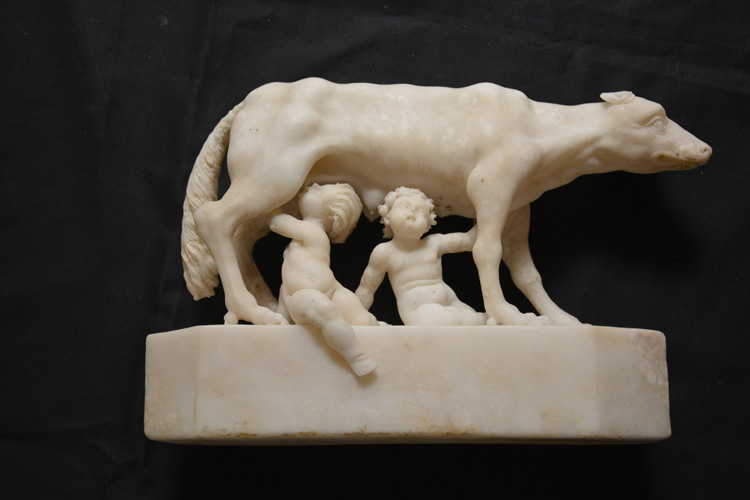Statuette of she-wolf suckling twins
Category
Gozo GroupAbout This Artefact
I.D. no: 32322
Dimensions: H. 24 cm; W. at base 8.5 cm.
Material: Fine-grain, rather translucent, white marble
Provenance: Reputedly discovered in Fontana, Gozo in 1720.[1]
Current location: Museum of Archaeology, Gozo
Condition: Practically intact, except for the broken right ear and the end of the left ear of the she-wolf, and the toes of the right foot of the left twin. The left twin has a roughened and discoloured back, as if affected by some acid. Similarly the right arm of the right twin and the inner surface of the wolf’s legs, as well as part of the surface of the base. Similar blotches are noted on the wolf’s head, left shoulder and as scattered drops on its body.
Description: The statuette represents a she-wolf standing on a proportionally high eight-sided base with two babies underneath it one of whom with his mouth attached to the animal’s udder. While the two babies look quite healthy and well-fed, the wolf is very lean with all its bones, including its rib cage protruding from under the skin. The treatment of its anatomy is quite detailed and burnished, almost polished in fact, apart from the roughened hair texture of the tail; the same rough texture is applied to the ruffled hair of the active and restless twins. Some further detail is spared to the eyes of the she-wolf, with engraved pupils and irises.
Discussion:
There is little doubt that, whenever this marble object was made, it was intended to manifest the Romanity of the place, whether it was Malta, Gozo, or anywhere else. It is modelled on the quintessential symbol of Rome the most celebrated example of which is the bronze Lupa Capitolina on display in the Museo Capitolino in Rome. The she-wolf suckling the twin founders of Rome, Romulus and Remus, was the ultimate iconographic expression of the mythical origin of the people of Rome and eventually, by extension, of all the citizens of the Roman empire. But, irrespective of the twins, which were added to the Capitoline bronze statue in the Renaissance, the Gozo she-wolf bears little resemblance to the Roman one, apart from its stance, with all four legs planted steadily on the ground. Even the head is directed almost straight ahead along the axis of the body, just slightly turned to its left, unlike the Roman counterpart whose head is turned almost at right angle in the same direction. In a representation of the full theme (she-wolf and twins) on a Roman silver coin dated to c. 269– 266 BC, the she-wolf turns her head back 1800. In terms of modelling, the lean Gozo she-wolf is closer to smaller representations in relief than to the famous free-standing one.[2]
Although some similarity in the skinny treatment of the Gozo she-wolf is found in a number of representations of it on ancient monuments, like the mentioned coins, its antiquity has frequently been questioned by archaeologists and historians of ancient art.[3] As far as post-Classical sculptures are concerned, one of the earliest representations is the Sienese she-wolf in the Victoria & Albert Museum[4], but the style and carving technique are very close to those of two reliefs in the sixteenth-century ‘Style of Bambaia’ in the same museum.[5]
Precisely because the Gozo small-scale statuette shows no sculptural and stylistic qualities that one can define as typically Roman, I find no reason to contradict previous scholars who in their majority have assigned the sculpture to modernity, more specifically to the Renaissance.
Bibliography: (previous publications of item): Agius de Soldanis 1746: f. 67. Boisgelin 1804: vol. 1: 8, pl. 4, fig. 7. Bres 1816: 348. Caruana 1882: 112: probably a renaissance work. Ashby 1915: 70: from ‘the ruins of Ghain-el-Cbira, near the castle of Gozo’. Pietrangeli 1942: 1, 8: ‘sicuramente opera del ‘500 o del ‘600’.
[1] Agius de Soldanis 1746: f. 67 ; Ashby 1915: 70
[2] Such as the relief on the Altar to Mars and Venus from Ostia, now in the Palazzo Massimo alle Terme, which has the same posture and head turned back, whereas it appears reclining on one corner of the statue group with the allegory of the Tiber.
[3] Such as Caruana 1882: 112; Pietrangeli 1942: 1, 8.
[4] Pope-Hennesy 1964: no. 277.
[5] Pope-Hennesy 1964: nos 585, 583, pls 569, 571.



